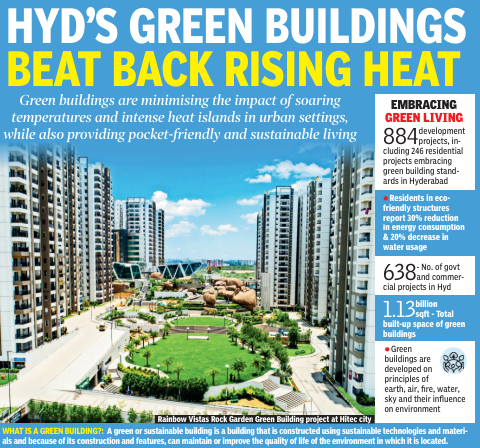The city is sizzling above 43°C – as it does every summer season – but residents in the 246 green residential building projects dotting Hyderabad’s landscape, are not facing the heat, literally, while also saving 700-1,000 on monthly power bills. The temperature in homes within these green buildings is at least two to three degrees lower, which also translates into saving electricity.


There residents here thank the green infrastructure, which has emerged as a powerful tool to combat urban heat islands and offer respite from scorching heat.
SAVINGS ON POWER BILLS
“Residing in a green building has been an ideal choice for our family,” said P Subash Reddy, a resident of Green Grace apartments in Khajaguda. “The design allows for plenty of natural light and ventilation, minimizing our reliance on artificial lighting. When compared to traditional houses, the indoor temperatures in green buildings are noticeably cooler. Additionally, the installation of solar-powered water heaters has led to significant savings on our electricity bills. All together, we are registering a monthly savings of at least 700 per month on power bills.”
Currently, Hyderabad has over 884 development projects that are certified as green buildings by the Indian Green Building Council (IGBC). The council is headquartered in the city and in fact, its 20,000 square feet office is considered among the biggest green properties in India and it is also the country’s first platinum rated green building.


Another example is: Rainbow Vistas at Rock Garden. Here too residents share how the summers have been less taxing. “One of the primary benefits of the green building is the increased space, which allows for a more spacious living environment. Additionally, proper ventilation ensures a healthy flow of fresh air, promoting better indoor air quality, particularly during summers,” said Madhu Sudhan Reddy, a resident. The environment friendly features of the property includes gardening, lawns, cross ventilation, sewage treatment plants (STP) for water recycling and rainwater harvesting.
GROWING INTEREST AMONG CITIZENS
According to IGBC, several government buildings in Hyderabad have adopted green building ratings, including the Integrated Command and Control Centre, Telangana Secretariat, Secunderabad, Hyderabad, and Kacheguda railway stations, Rail Nilayam building, and Rajiv Gandhi International Airport. Private organizations such as Capgemini, Dell, Waverock, D.E Shaw, K Raheja IT Park Mindspace, Inorbit Mall, Jayabheri-The Peak, My Home Avatar, Aparna Sarovar, and Rainbow Vistas at Rock Garden have also embraced these ratings.
C Shekhar Reddy, vice-chairman of IGBC, attributed the transformation of Hyderabad’s green building landscape to the growing interest among its citizens. “By reducing energy consumption, minimizing water usage, and promoting waste management, green buildings play a pivotal role in conserving our planet’s finite resources,” he said.
M Anand, deputy executive director, stated that green buildings require an additional 2% investment compared to a conventional residential project, but the investment pays back within 18 months through savings in power and water bills.
SO, WHAT QUALIFIES AS A GREEN BUILDING?
To be certified as a green building, the IGBC has established a set of criteria that focus on sustainability, energy efficiency, water conservation, and environmental quality. These buildings optimize their envelopes to reduce heat and incorporate cool roof designs to mitigate direct solar heat gain, resulting in energy consumption savings of 20-30%.
Green buildings utilize alternative materials such as AAC blocks and fly ash blocks for walls, efficient glass for windows, passive design strategies, and effective lighting and cooling systems.
In terms of water usage, green buildings are making significant progress by reducing consumption by 30-50%. This is achieved through use of aerators and low-flow fixtures, water harvesting pits and tanks, and treating wastewater for landscaping and flushing.


















